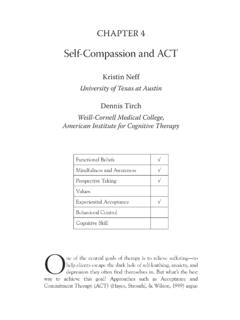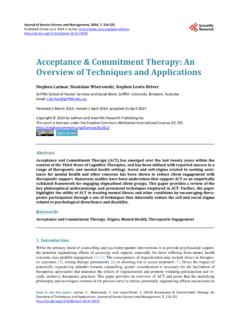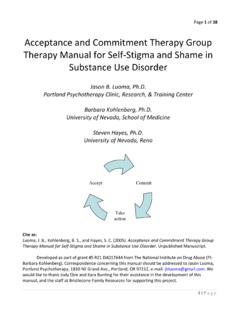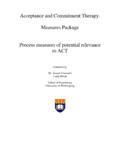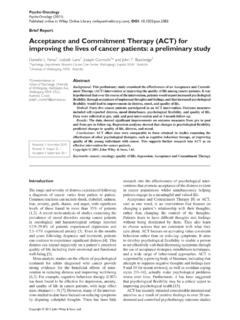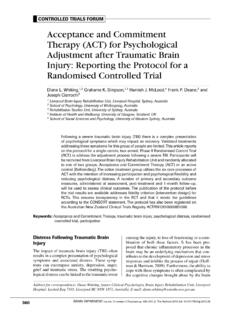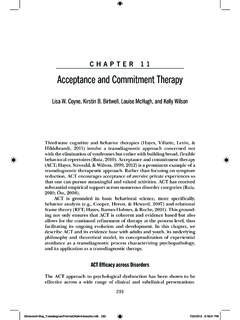Transcription of Acceptance and Commitment Therapy (ACT)
1 Acceptance and Commitment Therapy (ACT) Acceptance and Commitment Therapy (ACT) is a contextually focused form of cognitive behavioral psychotherapy that uses mindfulness and behavioral activation to increase clients' psychological flexibility--their ability to engage in values-based, positive behaviors while experiencing difficult thoughts, emotions, or sensations. ACT has been shown to increase effective action; reduce dysfunctional thoughts, feelings, and behaviors; and alleviate psychological distress for individuals with a broad range of mental health issues (including DSM-IV diagnoses, coping with chronic illness, and workplace stress). ACT establishes psychological flexibility by focusing on six core processes: Acceptance of private experiences ( , willingness to experience odd or uncomfortable thoughts, feelings, or physical sensations in the service of response flexibility) Cognitive defusion or emotional separation/distancing ( , observing one's own uncomfortable thoughts without automatically taking them literally or attaching any particular value to them) Being present ( , being able to direct attention flexibly and voluntarily to present external and internal events rather than automatically focusing on the past or future) A perspective-taking sense of self ( , being in touch with a sense of ongoing awareness)
2 Identification of values that are personally important Commitment to action for achieving the personal values identified The first four processes define the ACT approach to mindfulness, and the last two define the ACT approach to behavioral is delivered to clients in one-on-one sessions, in small groups or larger workshops, or in books or other media, through the presentation of information, dialogue, and the use of metaphors, visualization exercises, and behavioral homework. The number and length of sessions and the overall duration of the intervention can vary depending on the needs of the client or the practice of the treatment studies reviewed for this summary, ACT was used to (1) reduce symptoms of depression and the severity of obsessions or repetitive behaviors/mental acts associated with obsessive-compulsive disorder (OCD), (2) relieve the distress associated with delusions and hallucinations in acutely psychotic inpatients, and (3) improve general mental health in study participants by increasing their ability to cope with workplace stress.
3 ACT also has been used in other areas, including the treatment of phobias, depression, trichotillomania, and substance abuse; smoking cessation; coping with end-stage cancer, type 2 diabetes, and epilepsy; and the management of chronic pain. In nonclinical settings, such as worksites, the intervention is also known as Acceptance and Commitment Training to avoid any stigmatizing impact of the word " Therapy ."Descriptive InformationAreas of Interest Mental health promotion Mental health treatment Outcomes Review Date: July 2010 1: Obsessive-compulsive disorder symptom severity 2: Depression symptoms 3: Rehospitalization 4: General mental health Outcome Categories Mental health Treatment/recovery Ages 18-25 (Young adult) 26-55 (Adult) 55+ (Older adult) Genders Male Female Races/Ethnicities American Indian or Alaska Native Quality of ResearchReview Date: July 2010 Asian Black or African American Hispanic or Latino White Race/ethnicity unspecified population Settings Inpatient Outpatient Workplace Geographic Locations Urban Suburban Implementation History ACT was first implemented in the mid-1980s and was fully systematized in 1999.
4 Since then, tens of thousands of practitioners have received training in the intervention. ACT has been used by hundreds of programs and agencies, ranging from those that include ACT as part of their treatment to organizations that use ACT as the model for their entire treatment program. Over 40 studies have been conducted on specific components of ACT, as well as over 50 effectiveness or efficacy trials; combined, this research covers several thousand participants. Articles have been published on ACT studies conducted in Australia, Canada, Finland, India, Japan, the Netherlands, South Africa, Spain, Sweden, the United Kingdom, and the United States. More than 60 books on ACT have been published. ACT development is guided by the Association for Contextual Behavioral Science (ACBS), which can provide referrals to professionals in a specific area of interest. ACBS also has a worldwide system of recognized trainers ( ) who are available to assist agencies interested in implementation.
5 NIH Funding/CER Studies Partially/fully funded by National Institutes of Health: Yes Evaluated in comparative effectiveness research studies: Yes Adaptations ACT materials have been translated into Danish, Dutch, French, German, Italian, Norwegian, Portuguese, Spanish, and Swedish. Adverse Effects No adverse effects, concerns, or unintended consequences were identified by the developer. IOM Prevention Categories Indicated Documents ReviewedThe documents below were reviewed for Quality of Research. The research point of contact can provide information regarding the studies reviewed and the availability of additional materials, including those from more recent studies that may have been 1 Twohig, M. P., Hayes, S. C., Plumb, J. C., Pruitt, L. D., Collins, A. B., Hazlett-Stevens, H., et al. (2010). A randomized clinical trial of Acceptance and Commitment Therapy versus Progressive Relaxation Training for obsessive-compulsive disorder. Journal of Consulting and Clinical Psychology, 78(5), 705-716.
6 Study 2 Bach, P., & Hayes, S. C. (2002). The use of Acceptance and Commitment Therapy to prevent the rehospitalization of psychotic patients: A randomized controlled trial. Journal of Consulting and Clinical Psychology, 70(5), 1129-1139. Study 3 Bond, F. W., & Bunce, D. (2000). Mediators of change in emotion-focused and problem-focused worksite stress management interventions. Journal of Occupational Health Psychology, 5(1), 156-163. Supplementary Materials Banks, M. H., Clegg, C. W., Jackson, P. R., Kemp, N. J., Stafford, E. M., & Wall, T. D. (1980). The use of the General Health Questionnaire as an indicator of mental health in occupational studies. Journal of Occupational Psychology, 53, , B. A., & Herbert, J. D. (2006). Acute treatment of inpatients with psychotic symptoms using Acceptance and Commitment Therapy : Pilot results. Behaviour Research and Therapy , 44(3), 415-437. Goodman, W. K., Price, L. H., Rasmussen, S. A., Mazure, C.
7 , Delgado, P., Heninger, G. R., et al. (1989). The Yale-Brown Obsessive Compulsive Scale. II. Validity. Archives of General Psychiatry, 46(11), 1012-1016. Goodman, W. K., Price, L. H., Rasmussen, S. A., Mazure, C., Fleischmann, R. L., Hill, C. L., et al. (1989). The Yale-Brown Obsessive Compulsive Scale. I. Development, use, and reliability. Archives of General Psychiatry, 46(11), 1006-1011. Hayes, S. C., Luoma, J. B., Bond, F. W., Masuda, A., & Lillis, J. (2006). Acceptance and Commitment Therapy : Model, processes and outcomes. Behaviour Research and Therapy , 44(1), 1-25. Twohig, M. P., Hayes, S. C., & Masuda, A. (2006). Increasing willingness to experience obsessions: Acceptance and Commitment Therapy as a treatment for obsessive-compulsive disorder. Behavior Therapy , 37(1), 3-13. OutcomesOutcome 1: Obsessive-compulsive disorder symptom severityDescription of Measures The severity of OCD symptoms was measured by the Yale-Brown Obsessive Compulsive Scale (Y-BOCS), a 10-item structured interview administered by a clinician.
8 The Y-BOCS separately measures the severity of obsessions and compulsions on a 5-point scale that ranges from 0 (no symptoms) to 4 (extreme symptoms), generating a total score that ranges from 0 to 40. The Y-BOCS total score indicates whether symptoms are subclinical (0-7), mild (8-15), moderate (16-23), severe (24-31), or extreme (32-40). For the study, researchers defined a pre- to postintervention change of points in the Y-BOCS total score as reliable and clinically significant. Assessments occurred 1 week before treatment (baseline) and 1 and 12 weeks after treatment (follow-ups). Key Findings In a randomized clinical trial, adults with a DSM-IV diagnosis of OCD were assigned to eight sessions of either ACT or Progressive Relaxation Training (PRT). Participants in each group had a reduction in OCD symptom severity from baseline to both posttreatment follow-up assessments (p < .001 and p < .001 for participants who received ACT and PRT, respectively).
9 However, compared with PRT participants, ACT participants had larger and more rapid reductions in OCD symptom severity (p = .026); this group difference was associated with a large effect size (Cohen's d = ). A higher percentage of ACT than PRT participants reported clinically significant reductions ( points in the Y-BOCS total score) from baseline to 1 week after treatment (56% vs. 18%; p < .002) and from baseline to 12 weeks after treatment (66% vs. 16%; p < .001); the effect sizes for these differences were medium and large (Cohen's d = and for the 1- and 12-week follow-ups, respectively). Studies Measuring Outcome Study 1 Study Designs Experimental Quality of Research Rating ( scale) Outcome 2: Depression symptomsDescription of Measures Depression symptoms were measured with the Beck Depression Inventory--II (BDI-II). The BDI-II is a 21-item self-report instrument that assesses the presence and severity of depression symptoms according to DSM-IV criteria.
10 Like the DSM-IV, the BDI-II evaluates symptoms of depression during the 2 weeks prior to assessment. Participants respond to 19 items using a 4-point scale and 2 items using a 7-point scale. The BDI-II total score ranges from 0 to 63 and indicates whether symptoms of depression are minimal (0-13), mild (14-19), moderate (20-28), or severe (29-63). Assessments occurred 1 week before treatment (baseline) and 1 and 12 weeks after treatment (follow-ups). Key Findings In a randomized clinical trial, adults with a DSM-IV diagnosis of OCD were assigned to eight sessions of either ACT or PRT. An analysis of study participants with at least a mild baseline level of depression symptoms (BDI-II score of 13 70% of the participants) showed that ACT participants had greater reductions in depression symptoms than PRT participants from baseline to 1- and 12-week posttreatment follow-up assessments (p = .002 and p < .05, respectively). The group differences at the 1- and 12-week follow-ups were associated with large and medium effect sizes (Cohen's d = and , respectively).

